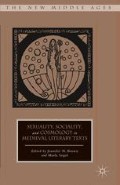Abstract
Helen Waddell (1889–1965), the famed playwright, editor, and translator, found the life of Thais to be “the crudest of the Vitae Patrum,” and Pafnutius to be “the harshest figure” (262). She calls it a “revolting story” and, though she credits Anatole France’s novelistic adaptation of it as “the subtlest indictment of asceticism in European literature” (261), she wonders why he did not simply turn the page and work with the Pelagia story instead, as she herself did.1 The story of Thais is a typical prostitute-turned-penitent conversio legend, such as that of Pelagia or Mary Magdalene. In the Latin version of the legend, the famous desert father Pafnutius seeks out and converts the prostitute Thais. Persuaded by his exhortations, she burns all of her money and goods and follows him to a female community where she is interred as an anchoress. After three years, he releases her from her cell. She dies shortly thereafter, a saintly woman. It is a tale of abjection, first and foremost, showcasing a prostitute, who by virtue of her profession refuses to fit into the place assigned her by society, as the Christian who sins despite her faith. In its rudimentary form, the legend serves as an indictment against lascivious behavior and seeks to rein in the ever present threat of female seduction, reaffirming the proper universal order of reason over sense, male over female, and spiritual over physical.
Access this chapter
Tax calculation will be finalised at checkout
Purchases are for personal use only
Preview
Unable to display preview. Download preview PDF.
Notes
Hrotsvit, Hrotsvithae Opera, ed. Helen Homeyer (Paderborn: Schöningh, 1970), p. 233; The Plays of Hrotsvit of Gandersheim, trans. Katharina Wilson (New York: Garland, 1989), p. 3. Here and elsewhere, unless otherwise noted, I use Homeyer’s edition and Wilson’s translation with my emendations, as needed, in brackets.
Peter Dronke notes that the Archbishop Bruno seemed to favor Terence (Peter Dronke, Women Writers of the Middle Ages [Cambridge: Cambridge University Press, 1984], p. 57).
Katrinette Bodarwé argues that Terence’s plays were standard reading for women’s monastic communities in Ottonian Saxony in Katrinette Bodarwé, Sanctimoniales litteratae: Schriftlichkeit und Bildung in den ottonischen Frauenkommunitaten, Quellen und Studien 10, (Münster: Aschendorff, 2004); clearly, Hrotsvit’s community at Gandersheim had access to at least one copy. A copy from the royal monastery at Essen survives, and there is evidence to suggest that Queen Mathilda’s foundation at Quedlinburg also had more than casual acquaintance with the plays of Terence. See her Sanctimoniales litteratae.
In addition to his novel Thais, France wrote two essays that recall this performance: “Hrotswitha aux Marionnettes” and “Les Marionettes de M. Signoret.” Anatole France, “Hrotswitha aux Marionnettes,” La Vie Litteraire, vol. 3 (Paris: Calmann-Levy, 1911), 3:10–19
Anatole France, “Les Marionettes de M. Signoret,” La Vie Litteraire, vol. 2. (Paris: Calmann-Levy, 1911) 2:145–50.
Anatole France, Thais, trans. Basia Gulati, (Chicago: Chicago University Press, 1976).
Much has been written on the question of gender and souls as perceived in early Christian theology. On the particular question of women and imago Dei, see E. Ann Matter’s, “Undebated Debate: Gender and the Image of God in Medieval Theology,”, Gender in Debate from the Early Middle Ages to the Renaissance, ed. Thelma S. Fenster and Clare Lees (New York: Palgrave, 2002), pp. 41–55, where she argues that church authorities were intentionally silent or ambiguous on the question so as not to codify in the affirmative. The fact that the Catholic Church to this day does not ordain women suggests that the female soul is still not regarded as equal to the male soul.
For a discussion of female subject formation in this play as well as the plays of Hrotsvit of Gandersheim more generally, see Helene Scheck, Reform and Resistance: Formations of Female Subjectivity in Early Ecclesiastical Culture, 750–1000, (Albany: State University of New York Press, 2008).
Immanuel Kant, Lectures on Ethics, trans. L. Infield (New York: Harper and Row, 1963), p. 165;
Carole Pateman, “What’s Wrong with Prostitution?”, The Sexual Contract (Stanford: Stanford University Press, 1988), p. 204 [pp. 189–218].
Susannah Mary Chewning, “Mysticism and the Anchoritic Community: ‘A Time … of Veiled Infinity,’”, Medieval Women in Their Communities, ed. Diane Watt (Toronto: University of Toronto Press, 1997), p. 129 [pp. 116–37].
For the question of gender and imago Dei, see E. Ann Matter, “The Undebated Debate: Gender and the Image of God in Medieval Theology,”, Gender in Debate from the Early Middle Ages to the Renaissance, eds. Thelma S. Fenster and Clare A. Lees, pp. 41–55. (New York: Palgrave, 2002), where she argues that the question of whether or not women were created in the image of God never came to debate and therefore prevented any official recognition of women as complete, autonomous subjects (especially p. 42, p. 45).
Editor information
Copyright information
© 2013 Jennifer N. Brown and Marla Segol
About this chapter
Cite this chapter
Scheck, H. (2013). The Whore as Imago Dei: Being and Abjection in Hrotsvit’s Rewriting of Thais. In: Brown, J.N., Segol, M. (eds) Sexuality, Sociality, and Cosmology in Medieval Literary Texts. The New Middle Ages. Palgrave Macmillan, New York. https://doi.org/10.1057/9781137037411_2
Download citation
DOI: https://doi.org/10.1057/9781137037411_2
Publisher Name: Palgrave Macmillan, New York
Print ISBN: 978-1-349-29229-5
Online ISBN: 978-1-137-03741-1
eBook Packages: Palgrave Literature CollectionLiterature, Cultural and Media Studies (R0)

